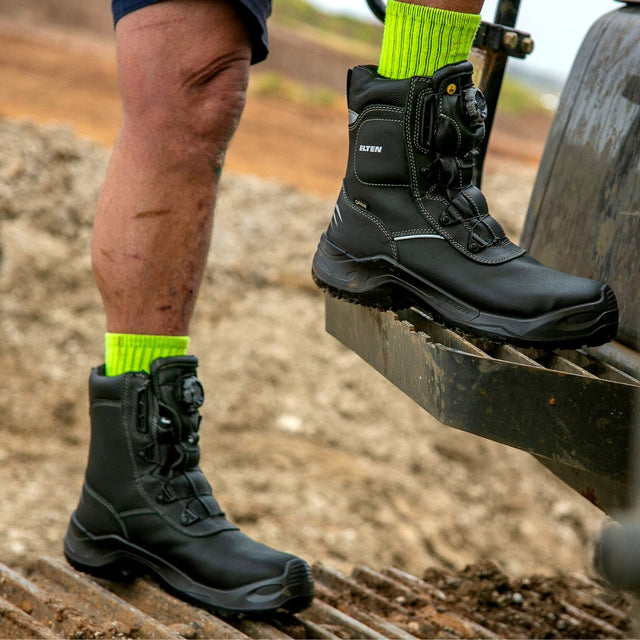How is slip resistance or anti-slip measured in work boots and safety shoes?
It's technical, but essential - understanding what sole will keep you safe at work.
Slip resistance or anti-slip properties in work boots and safety shoes are typically measured and rated using a set of standards established by the European Union. The primary standard used for evaluating slip resistance is EN ISO 20345:2011 or for safety footwear.
This standard is part of the larger EN ISO 20345 standard, which covers safety requirements for occupational footwear.
Here's how slip resistance is measured and evaluated in work boots and safety shoes:
-
Testing Surfaces: The EN ISO 20345 or AS/NZS standard specifies the use of specific surfaces for slip resistance testing. These surfaces include:
- SRA: Boots tested on ceramic tiles covered with a sodium lauryl sulphate (SLS) solution, simulating a slippery, soapy floor.
- SRB: Boots tested on steel floors covered with glycerol, simulating a slippery, oily surface.
- SRC: Footwear that meets both the SRA and SRB standards is given the SRC rating, indicating superior slip resistance.
- SRA: Boots tested on ceramic tiles covered with a sodium lauryl sulphate (SLS) solution, simulating a slippery, soapy floor.
-
Testing Methods: Slip resistance is tested using a standardized machine, often referred to as a "Pendulum Test Rig."
This machine mimics the action of a person walking and measures the frictional force between the shoe sole and the test surface.
The test involves the following steps:- A weighted pendulum swings across the test surface, with the shoe sole attached to the pendulum.
- The pendulum's motion is stopped by the shoe's interaction with the surface, and the angle of the pendulum at rest is recorded.
- The recorded angle is used to calculate the Coefficient of Friction (COF) or the slip resistance value of the shoe on the specific surface.
- A weighted pendulum swings across the test surface, with the shoe sole attached to the pendulum.
-
Rating and Marking: Based on the test results, work boots and safety shoes are rated and marked with one of the following designations:
- SRA: Slip resistance on ceramic tiles with SLS solution.
- SRB: Slip resistance on steel with glycerol.
- SRC: Footwear that meets both SRA and SRB requirements.
Our selection of the most popular anti-slip work boots & safety shoes in Australia
ELTEN SENEX BOA Lightweight Work Shoe SRC
ELTEN STEFANO GTX Waterproof Work Boot SRC
ELTEN REACTION Lightweight Work Boot SRC
ELTEN REACTION Lightweight Work Shoe SRC
SANDER BOA Lightweight Work Boot SRC
ELTEN MILOW Composite Toe Cap Safety Shoe SRC
These markings provide information to users about the slip resistance properties of the safety footwear on specific surfaces, helping them make informed choices based on their work environment.
It's important to note that these standards are in place to ensure a certain level of safety, but real-world performance may vary depending on factors like wear and tear, contamination of the sole, and individual walking habits. Therefore, it's essential for users to choose steel or composite toe caps in Australia that meet the specific requirements of their workplace and to regularly inspect and maintain their shoes for optimal slip resistance.
Feel free to contact our friendly customer service team in Melbourne on 03 6161 3933 or hello@stitchkraft.co or visit our store on www.sitchkraft.com.au for any further queries you have around slip resistance or anti-slip properties of Elten safety footwear or our huge range of ELTEN work boots and safety shoes on www.stitchkraft.com.au.

